
|
The world of non-commercial film and A-V |
Events Diary | Search | ||
| The Film and Video Institute | | ||||
The making of Amber
Amber by Samuel Faict got a Diamond award at BIAFF 2009. His film The Gift was awarded 4-stars. Samuel's first BIAFF success was with Angelus Mortis and Shortcut which had Silver Plus and Released which won Silver in 2006. Read about the making of his 2008 4-star winner Valentijn.
Samuel Faict - a need to communicate
|
One shot of a sunset may speak volumes I turned 26 on the 16th of February 2009. When I was 13, my sister was 11 and my brother only 2½, our family life changed drastically. My mother died after battling cancer for two years. Mum wanted me to become a doctor. She used to watch lots of classic movies and thanks to her I was hooked on filmmaking at an early age. I became fascinated by fantasy and science fiction films such as Star Wars, Back to the Future, Alien, Predator and Terminator. At the moment I am studying directing in a studio for experimental film in St Lucas High School, Brussels. The workshop's film focus is not so much on making a clear, logical and comprehensible message as on making movies which meet the filmmaker's expectations and intent. A film may work without a pure, classic narrative structure. One shot of a sunset may speak volumes. After having arranged different frames in a specific order you can start to tell a story. A picture without any clear message may nonetheless express powerful feelings, which is one way of explaining something. |
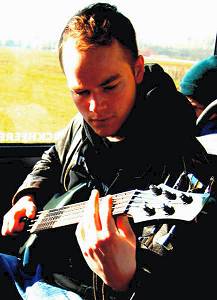 |
What is important here is the personal evolution of the filmmaker in respect of his work. If the audio visual work is the expression of the maker's intention, then it is all right. The working process is more important than the result, but a good result is not to be despised!
At present I am active in Film and Videoclub Focus Vaartland. The members don't always understand my audio visual approach, but I have always been supported by the president, Willy Van der Linden, Ludo Sollie and some other clubmates. I am very grateful to them.
I am enthralled by spirituality, by ancient cultures such as the Maya's and by quantum physics. I love to be absorbed in and baffled by fascinating philosophical reflections on science and spirituality.
The inspiration
My other film, The Gift, was inspired by what happened to my mother. Having a baby (in this case my brother) and being taken away from us shortly after by a fatal disease ...
For Amber I found inspiration in the nightlife of parents who take their children with them to pubs. Some adults don't care that their youngsters play until late in the dense, stinking smoke of beer and cigarettes and eventually fall asleep on dirty tables. The scenario developed into the portrait of a child who inhales the smoke of two adults and herself becomes a liquid that they drink. Ironically enough the girl in the film and her father, who plays a supporting role in the crowd, really live like that. Luckily they are not so bad as many others.
The biggest problem was finding a leading actress. Nora, the girl in the film, had appeared in one of my previous films and I wanted to cast her again. It was a delicate problem. The theme is about children in pubs and she is a victim herself because of her parents' lifestyle. Her father didn't mind. He was actually proud that his daughter would be a film star again.
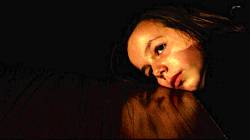 |
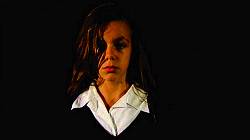 |
An artist must be subservient to his work
If there are difficulties during film making, I try to solve them in an artistic way. An artist must be subservient to his work and not vice versa. He must "obey" his work. He must feel it. Sometimes things happen in an unexpected way. The result is different - not better or worse. It is important to make the right choices by thinking quietly and deeply about every detail and by visualising the outcome. Vision is very important.
Another problem I am faced with is that some people take a negative view of films that diverge strongly from the classic Hollywood narrative narrative structure. I make such films because they give me enough mental space. I always try to reflect feelings in images. Poets do the same with words. My films are an artistic expression of who I am, how I feel and how I consider problems in the world around me.
I have a need to communicate my feelings to other people. However, I would like to make it clear that there is nothing wrong with interpreting the film in a different way. If people eat fish and chips every day it's a shock to have an Indian dish. They find it special, but they still prefer fish and chips. People should try different things and filmmakers should prepare exquisite, unusual dishes. They may fail, but if they don't try, they get cramped and don't evolve.
Please, don't watch my films expecting Hollywood style or you will be banging your head against a wall. Film is a form of expression. My films are quite different. If you think that only the Hollywood way is right, then automatically you ignore more than half of the world's film traditions. Russian and Eastern films have their own specific way of telling stories. Every culture has its own characteristics and develops its own language. It's the job of an audio visual artist to create something in his own specific style.
A film screen is a passage to another world
For me a film screen is a passage to another world, just as Salvador Dali used his canvas. You don't have to understand his works of art, but you should be open to them, willing to be absorbed in his mental space. His metaphors don't need to be explained. The colours and forms speak for themselves. The experience of each viewer is personal and intimate.
David Lynch, Andreï Tarkovski, Peter Greenaway, Bill Viola, Chris Marker, Guy Maddin, Alexsandr Sokurov, Samuel Beckett, Shohei Imamura, Carl Theodor Dreyer, Adam Jones, Norman McLaren, The Brothers Quay... they are all cinema artists who became famous thanks to their unorthodox and unusual film language. They are artists who have always been loyal to their own mental places. They also used the screen as a door to a different mental world in which laws and logic have nothing to do with our conditioned western view of the world.
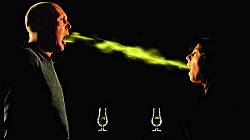 |
Making Amber
The scenario is the blueprint of what I am going to shoot. This has to be prepared in detail. It must feel right before I start shooting. You get that feeling after some time and experience. The more you do it, the more sensitivity and subtlety you achieve. The way images are framed and chosen meticulously to give more power to the filmed action . When you show a film then you contaminate the viewer with it. Sometimes he is unaware of having seen certain elements but his subconscience does catch them. The details make the difference.
Pre-production
First I write an outline. When I am happy with it a scenic synopsis follows. Eventually I make a scenario, the written description of the action to take place in the film. At least two people read it and I ask for their feedback. I create a storyboard, script and concept art.
Casting the actors is a very important step in the process. I organise readings with the actors and if necessary I adjust things. Thanks to scouting the locations I know what emotions those can evoke. Sometimes there are elements in the vicinity such as a motorway or an airport which would be annoying if I need to capture live sound on the set. Looking for the right props is also essential.
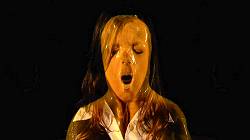 |
 |
Production
Tests and experimenting, making scale models and things like that are the next steps. Then follows shooting with a reliable crew. In other words people who are on the same wavelength. Re-shooting may be possible. Eventually I edit the film and work on the soundscape. After that I show the film to many different people, ask for feedback and make adjustments.
- Samuel Faict
Share your passions.

Share your stories.